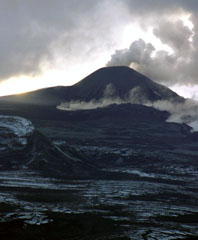Report on Montagu Island (United Kingdom) — November 2005
Bulletin of the Global Volcanism Network, vol. 30, no. 11 (November 2005)
Managing Editor: Richard Wunderman.
Montagu Island (United Kingdom) N-coast delta grew during 14 September-4 October 2005
Please cite this report as:
Global Volcanism Program, 2005. Report on Montagu Island (United Kingdom) (Wunderman, R., ed.). Bulletin of the Global Volcanism Network, 30:11. Smithsonian Institution. https://doi.org/10.5479/si.GVP.BGVN200511-390081
Montagu Island
United Kingdom
58.445°S, 26.374°W; summit elev. 1370 m
All times are local (unless otherwise noted)
MODVOLC radiant heat-flux data and ASTER high-resolution satellite imagery revealed discharging lava flows that traveled N to the sea where they constructed a lava delta. The large effusive episode described in BGVN 30:09 had ceased, followed by a smaller episode in November. MODVOLC responses were most intense during 14 September to 4 October 2005. Figure 11a shows the radiant heat flux for the volcano since the start of the eruption in October 2001, providing rough idea eruptive intensity. Figure 11b indicates the distance of each alert pixel from the vent, giving insights into the timing of significant effusive episodes.
 |
Figure 11. Plots of MODVOLC data at Belinda volcano on Montagu Island. Courtesy of Matt Patrick, HIGP. |
As figure 12b suggests, the September-October 2005 episode was likely the largest effusive episode of the eruption in that it involved the only sustained occurrence of alert pixels (i.e. active lava) more than 2 km from the vent. Following 4 October 2005, a single alert pixel appeared more than 3 km from the vent on 17 November 2005, but subsequent alert pixels were all near-vent. It is not yet clear if this 17 November anomaly represents the start of a substantial additional episode of lava effusion.
An ASTER image collected on 3 November 2005, shows the result from the September-October 2005 effusive episode (visible wavelength image shown in figure 12a). The shortwave infrared anomaly in this image (not shown) is minor compared to the 23 September 2005 image (BGVN 30:09), suggesting that any effusion had dropped to low levels by early November. The 3 November image indicates that a significant lava delta had formed on the N shore of the island during the September-October effusive phase (see arrow in figure 12a). The delta comprises two major lobes, and is approximately 400-500 m in width and length, equating to approximately 0.2 km2. An enlarged view of the visible image is provided in figure 12b, where the approximate path of the September-October 2005 lava flow is shown by the dotted arrow. The current coastline is shown by the dotted line, with the lava delta (denoted by solid arrow) clearly jutting out. Note the faint steam wisps extending E from delta's eastern margin. The thermal infrared image (band 14, at 11-micron wavelength) of the island is shown in figure 12c, and clearly indicates the anomalously warm delta.
A Royal Air Force overflight on 11 October 2005, captured an oblique photograph of the delta (not shown). The lava flow appears to have steeply cut through thick ice approaching the shore, producing a broad and relatively flat delta that is vigorously steaming from the delta margins in the photograph.
Geological Summary. The largest of the South Sandwich Islands, Montagu consists of a massive shield volcano cut by a 6-km-wide ice-filled summit caldera. The summit of the 11 x 15 km island rises about 3,000 m from the sea floor between Bristol and Saunders Islands. Around 90% of the island is ice-covered; glaciers extending to the sea typically form vertical ice cliffs. The name Mount Belinda has been applied both to the high point at the southern end of the summit caldera and to the young central cone. Mount Oceanite, an isolated peak at the SE tip of the island, was the source of lava flows exposed at Mathias Point and Allen Point. There was no record of Holocene activity until MODIS satellite data, beginning in late 2001, revealed thermal anomalies consistent with lava lake activity. Apparent plumes and single anomalous pixels were observed intermittently on AVHRR images from March 1995 to February 1998, possibly indicating earlier volcanic activity.
Information Contacts: Matt Patrick, University of Hawaii, Hawaii Institute of Geophysics and Planetology (HIGP) Thermal Alerts Team, 2525 Correa Road, Honolulu, HI 96822 (URL: http://modis.higp.hawaii.edu/); John Smelie, British Antarctic Survey, Natural Environment Research Council, High Cross, Madingly Road, Cambridge CB3 0ET, United Kingdom (URL: https://www.bas.ac.uk/); NASA Earth Observatory (URL: http://earthobservatory.nasa.gov/).


